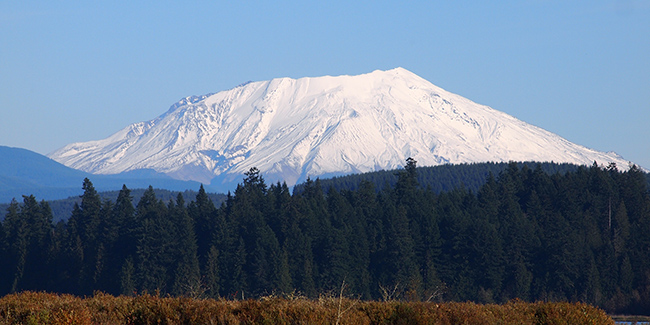Submitted by U.S. Geological Survey
May is Volcano Preparedness Month in Washington, providing residents an opportunity to become more familiar with volcanic risk in their communities and learn about steps they can take to reduce potential impacts.
Events offer face-to-face visits with scientists and emergency officials
For Volcano Preparedness Month, there will be multiple opportunities for public engagement. A full schedule of events is online. Here are some highlights:
On Wednesday, May 9 at 10:30 a.m. PDT, U.S. Geological Survey Cascades Volcano Observatory Scientist-in-Charge Seth Moran will deliver a State-of-the-Cascades report to begin a Live Facebook Chat session. Visit USGS Volcanoes on Facebook for more information.
(See Washington Governor Jay Inslee’s proclamation for 2017 Volcano Preparedness Month)
On May 12 from 10 a.m. to 5 p.m., the USGS–CVO will host a free, family-friendly, one-day public open house. Visitors can speak with scientists, tour labs and test their knowledge of volcano hazard zones and volcano safety. The public is invited to bring a favorite mystery rock to be identified by a geologist. Displays and demonstrations offer a sampling of work that happens daily at USGS–CVO.
On May 15, from 1 p.m. to 3 p.m., Washington Emergency Management Division will sponsor a Reddit “Ask-me-Anything,” with a focus on Cascade Volcanoes. A team of experts in volcanology, geology and preparedness will be on hand to answer any questions about our volcanoes that the internet community may ask them. Feel free to follow along.
Mount St. Helens’s Eruption Anniversary
On Sunday, May 18, 1980, at 8:32 a.m., the bulging north flank of Mount St. Helens slid away in a massive landslide. Seconds later, the uncorked volcano exploded and blasted rocks horizontally, destroying centuries of forest growth in a span of several minutes. Nine hours of explosive volcanic activity ensued, forever altering the landscape and what we know about volcanoes.
The Washington Military Department’s Emergency Management Division, Washington Department of Natural Resources, the Pacific Northwest Seismic Network (PNSN) at the University of Washington and the U.S. Geological Survey Cascades Volcano Observatory work together to provide timely warnings and reduce the negative impacts of future eruptions. Together, the agencies develop and exercise emergency plans with communities, coordinate communications, conduct public education programs and plan for short- and long-term recovery in the event an eruption or lahar should occur.
Keeping up with volcanoes – local resources
The USGS Cascades Volcano Observatory website has information about Volcano Preparedness Month events, as well as the USGS volcano-monitoring program and the hazards in the Washington and Oregon. Register for weekly updates and occasional information statements from the USGS Volcano Notification Service. Find information updates about volcanoes and read about science in action at USGS Volcanoes on Facebook.
Washington state’s Emergency Management Division website contains a section about the state’s volcanoes and volcano preparedness measures. Educational materials for children, families and communities are found in the publications section. Follow the agency’s Twitter feed, and Facebook page for breaking news and information. The Washington Geological Survey (a Division of the Washington State Department of Natural Resources) has developed a website that covers all aspects of Washington geology. They also have a volcano-specific webpage. Check out their Geologic Information Portal to learn about the hazards where you live, work, and play.
Preparing for future eruptions
The USGS–CVO, the PNSN, and the National Science Foundation-funded EarthScope Plate Boundary Observatory work to improve eruption forecasting and warning capabilities for Cascade volcanoes as part of the National Volcanic Early Warning System.




















































